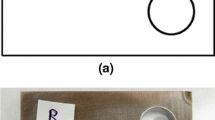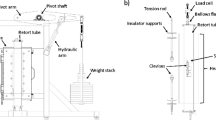Abstract
Next Generation Nuclear Plant (NGNP) designs for very-high-temperature reactors (VHTR) employ intermediate heat exchanger (IHX) for which the material demands are extreme. Currently, Alloy 617 and Alloy 800H are considered to be among the candidate materials for the high-temperature, helium-cooled environments that are planned for these systems. The primary helium coolant is expected to operate at temperatures at or above 750 °C, and creep crack growth (CCG) of these candidate alloys is of particular concern for their reliability in VHTRs for long-term service. Using an apparatus that was designed and constructed in-house, CCG testing was conducted on compact tension specimens at temperatures up to 850 °C in controlled environments, including air and impure helium, following ASTM standard E 1457-07. Overall, our CCG testing revealed that Alloy 617 exhibits superior resistance to creep crack growth compared to Alloy 800H. Trends observed in the mechanical behavior and microstructure of the candidate alloys as a function of environment will be discussed.
Access provided by Autonomous University of Puebla. Download conference paper PDF
Similar content being viewed by others
Keywords
27.1 Introduction
Next Generation Nuclear Plants (NGNPs) are being designed with a very-high-temperature helium-cooled reactor (VHTR) for generating electricity and co-generating hydrogen using the process heat from the reactor. The chosen coolant for these high-temperature reactor systems is helium, which is expected to be at 850–1,000 °C. Candidate alloys for intermediate heat exchangers (IHXs) are Inconel 617, Haynes 230, Alloy 800H and Hastelloy X. The helium coolant inevitably contains low levels of impurities during steady-state operation that are problematic because these alloys can experience significant long-term corrosion by the gaseous impurities present at elevated temperatures. These corrosion reactions, which may involve oxidation, carburization or decarburization, can substantially affect long-term mechanical properties. Little is known about the effects of impurities on the creep crack initiation and growth rate of these alloys at elevated temperatures. Scoping studies and eventually code studies are needed to provide specific guidelines for engineering design of IHXs in the presence of impure helium at high temperatures, and creep crack growth testing of candidate alloys in prototypical environments is an important component of those studies [1].
An apparatus for conducting creep crack growth (CCG) studies for candidate alloys at elevated temperatures and in controlled environments, including impure helium, was developed and described by the authors previously [2, 3]. Our work testing creep crack initiation and creep crack growth focused on two candidate materials, namely Inconel 617 and Alloy 800H, and CCG tests were performed within the temperature range 700–850 °C, which falls within the range stipulated by the “Nuclear Energy University Program Research Needs” released in December 2008 [4]. Here we will briefly discuss our observations of creep crack growth resistance in these materials. A full paper on the topic is in preparation.
27.2 Experimental Methods
The CCG testing apparatus developed by the authors relied on ASTM standard E 1457-07 [5] for performing creep crack growth measurements on metals and alloys. The apparatus simultaneously tests three compact tension (CT) specimens within an environmental chamber and under dead-weight loading. Samples are loaded within a retort tube that allows for high-temperature testing within a controlled environment. Tension rods, fabricated out of Inconel 617 alloy, deliver a constant load to the specimens throughout the testing duration.
Two candidate alloys were studied in detail: Alloy 617 and Alloy 800H. Alloy 617 is the leading candidate alloy for intermediate heat exchangers. It has been reported that Alloy 617 can be used at temperatures as high as 982 °C. Alloy 800H is currently approved under ASME code for nuclear service for up to 760 °C and could be used immediately in a lower-temperature reactor.
Table 27.1 presents the chemical compositions of the as-received alloys. All 617 and 800H samples used in these studies were provided by Dr. Richard Wright at Idaho National Laboratory (INL), Idaho Falls, ID, USA. The materials from INL were cut from much larger samples and were solution annealed. Before creep crack growth testing, both Alloy 617 and Alloy 800H were solution treated (ST) at 1,200 °C for 1 h, then quenched in water, then aged for 2,000 h in air at 850 °C. Aging of the alloys prior to CCG testing was done because the Alloy 617 and Alloy 800H materials will ultimately be used for extended periods of time and at high temperatures during heat exchanger service. The composition of the impure helium gas was 12 ppm CO, 1.5 ppm CO2, 0.5 ppm O2, 05 ppm N2, 05 ppm Ar, 0.2 ppm H2O moisture, with balance helium. The impure helium gas was premixed and certified by Airgas.
Numerous tests were conducted under various temperature and environmental conditions for Inconel 617 and Alloy 800H. Table 27.2 provides a summary of the tests that were successfully taken to completion. The direct current potential drop technique (DCPD) was used to conduct real-time monitoring of crack growth within each CT specimen (results to be presented in a future publication). The results presented herein focus on scanning electron microscopy (SEM) images taken of the cracks after the specimens were removed from the CCG testing apparatus. For all CCG tests, the direction of crack propagation was parallel to the rolling direction, and the cracks were prevented from propagating through the samples entirely in order to calibrate the DCPD measurements by quantifying the final crack length. To get reliable CCG data, the stress intensity for CCG testing of Alloy 800 has to be significantly lower as compared to the case of Inconel 617 at the same test temperature (700 °C).
27.3 Results and Discussion
The cracks that formed during CCG testing were investigated by SEM imaging. The major cracks visible on the outer surfaces (images not shown here) extended through the thickness of the samples, and crack branching was readily observed in all specimens. After cutting the CT specimens in half, it was found in all cases that major cracks within the interior of the specimens were longer than those found on the surface. The length of the longest crack within the interior of each specimen was used to quantify crack growth during CCG testing.
Figures 27.1 and 27.2 present SEM images of the crack morphologies of Alloy 617 specimens tested at 700 °C in air and in helium, respectively. One major crack is observed in the sample tested in air. There are many small crack branches in samples tested in helium. In both cases, some small crack initiations and/or cavitations are observed in front of the crack tip. In Fig. 27.1, crack propagation along the grain boundaries can be seen. It appears that the cracks initiated primarily from the triple point grain boundary junctions and near the carbide regions.
Crack, crack tip, crack cavitation, and crack initiations in Alloy 617 tested in air at 700 °C (Test 2). (a) Overall crack, (b) magnified crack tip in (a), (c) micro crack ahead of the crack tip, (d) crack initiation. The cracks initiated and propagated along grain boundaries. The cracks appeared to have initiated at the grain triple points and near the carbide areas
Figures 27.3 and 27.4 present SEM images of cracks in Alloy 617 specimens tested at 850 °C in air and helium, respectively. The crack morphologies appear to be similar to one another; namely, there is one major crack and many small cracks. It can be seen from the saw-shaped cracks in Fig. 27.3 that there is significant strain in Alloy 617 tested in air. In both cases, the cracks are intergrannular, and cracks appear to have initiated from the triple point grain boundary junctions and carbide regions.
Cracks in Alloy 617 tested at 850 °C in air (Test 4). (a) Overall crack, (b) crack tip area, (c) crack ahead of crack tip, (d) a crack initiation ahead of crack tip. Many small cracks are observed. Cracks are intergrannular, and cracks appear to have initiated from the triple points and near carbide regions
Figures 27.5 and 27.6 presents SEM images of the cracks in Alloy 800H specimens tested at 700 °C in air and in helium, respectively. One major crack is observed in each sample, and the crack tips are significantly oxidized. The cracks appear to have propagated along the grain boundaries and around the carbide phases.
27.4 Conclusion
An experimental testing apparatus was used to conduct creep crack growth studies for candidate alloys Alloy 617 and Alloy 800H at elevated temperatures and in controlled environments. The results obtained provide scoping information pertaining to long-term service in VHTR-type environments. CCG testing of candidate alloys revealed the effects of temperature and environment on crack-growth resistance within the parameter space explored. The creep cracks formed in both materials (Alloy 617 and Alloy 800H) tested at 700 and 850 °C in air and in helium were determined to be intergrannular. Alloy 617 was found to have superior CCG resistance to that of Alloy 800H under the conditions tested.
References
Shah VN, Majumdar S, Natesan K (2003) Review and assessment of codes and procedures for HTGR components NUREG/CR-6816, ANL-02/36
Grierson D, Cao G, Brooks P, Pezzi P, Glaudell A, Kuettel D, Fisher G, Allen T, Sridharan K, Crone WC. Experimental method for creep crack growth testing in controlled environments at high temperatures. Submitted to Experimental Mechanics
Grierson D, Cao G, Brooks P, Pezzi P, Glaudell A, Kuettel D, Fisher G, Allen T, Sridharan K, Crone WC (2013) An apparatus for creep crack growth testing in controlled environments at high temperatures. In: Proceedings of the 2013 SEM annual conference and exposition on experimental and applied mechanics, Albuquerque
Center for Advanced Energy Studies, Idaho National Laboratory (2008) Nuclear Energy University programs research needs, p 35
ASTM International. (2013) Standard test method for measurement of creep crack growth times in metals, ASTM E 1457-13
Haynes International, Inc. (2014) Corrosion-resistant & high-temperature alloys. http://www.haynesintl.com/. Accessed 5 March 2014
Acknowledgements
The authors would like to thank Dr. Richard Wright of INL and Dr. Sam Sham of ORNL for helpful discussions regarding sample processing and testing. This research was performed using funding received from the U.S. Department of Energy Office of Nuclear Energy’s Nuclear Energy University Programs under Battelle Energy Alliance, LLC Standard Research Contract No. 00088925, entitled “Assessment of Embrittlement of Very High Temperature Reactor Structural Alloys in Impure Helium Environments,” to the University of Wisconsin, under Prime Contract No. DE-AC07-05ID14517.
Author information
Authors and Affiliations
Corresponding author
Editor information
Editors and Affiliations
Rights and permissions
Copyright information
© 2015 The Society for Experimental Mechanics, Inc.
About this paper
Cite this paper
Grierson, D. et al. (2015). Creep Crack Growth in High-Temperature Impure Helium Environments. In: Carroll, J., Daly, S. (eds) Fracture, Fatigue, Failure, and Damage Evolution, Volume 5. Conference Proceedings of the Society for Experimental Mechanics Series. Springer, Cham. https://doi.org/10.1007/978-3-319-06977-7_27
Download citation
DOI: https://doi.org/10.1007/978-3-319-06977-7_27
Published:
Publisher Name: Springer, Cham
Print ISBN: 978-3-319-06976-0
Online ISBN: 978-3-319-06977-7
eBook Packages: EngineeringEngineering (R0)










